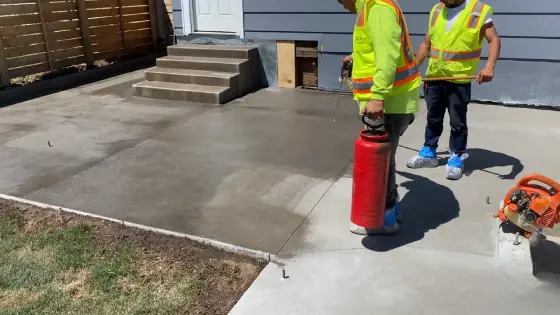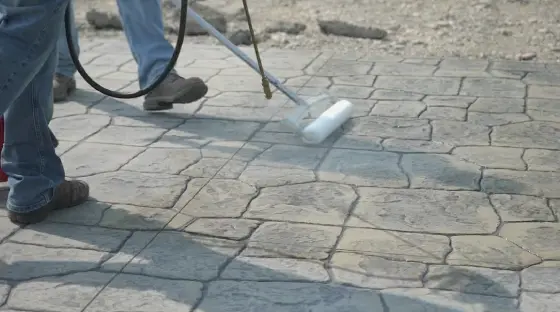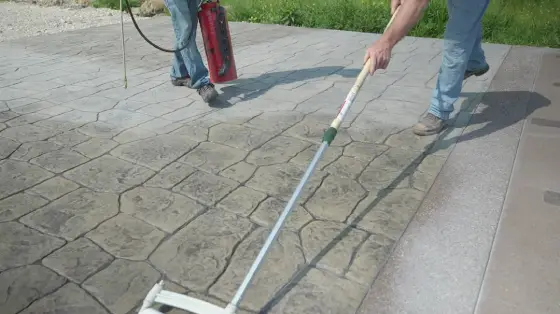Concrete sealer preserves the durability of concrete surfaces and protects them from the harmful effects of moisture, chemicals, and other damaging elements. The application of concrete sealer can be a challenging task, and the decision to roll or spray it is a critical one.
Generally, the selection between rolling or spraying depends on several factors, such as the surface’s square footage, the type of sealer, and personal preference.
Spraying is a fast and efficient option for commercial floors with large surface areas. On the other hand, rolling is a more suitable choice for smaller surfaces, such as garages or any other external surfaces. For concrete surfaces to remain durable, you must use the right technique and sealer.
Discover the best method to seal concrete. read on to understand the advantages and disadvantages of rolling vs. spraying techniques.
Is It Better to Use a Roller or Spray Concrete Sealer: Pros and Cons

Discover the two best ways to apply concrete sealer: with a roller or a spray. Rolling offers precision and deep surface penetration but can be time-consuming and leave unsightly marks. Spraying is perfect for larger areas but requires more prep and cleanup due to the risk of overspray.
Roller Application Benefits
- Control and Even Coverage
- Ideal for Smaller Areas
- Cost-effective
Spray Application Benefits
- Time-saving
- Smooth Finish
- Suitable for Intricate Surfaces
Roller Application Benefits
The utilization of a roller in the application of concrete sealer provides multiple advantages.
1. Control and Even Coverage
The optimal application of a sealant requires a technique that can provide precise control and consistent coverage, ensuring an even and uniform finish. Rolling the concrete sealer can provide these benefits as it allows for greater control over the process and achieves uniform coverage.
Unlike spraying, rolling allows the applicator to adjust the amount of pressure applied, ensuring that the sealer penetrates the concrete surface evenly. This technique also allows for greater precision when working around edges and corners, where spraying may result in overspray.
2. Ideal for Smaller Areas
The practicality and maneuverability of using a roller make it an ideal choice for smaller areas when applying a concrete sealer. It’s an effective tool for coating corners and edges, and the maneuverability of the roller is excellent for covering intricate details of the surface.
However, it’s important to note that the choice of roller affects the concrete’s texture and finish. The textured finish is possible with certain rollers, and personal preferences may differ depending on what type of concrete surface appearance is desired.
3. Cost-effective
The use of roller application for sealant can provide a financially efficient option for surface sealing, as it does not require specialized equipment. Using a roller can reduce the amount of wasted sealant, making it a more cost-effective option than spraying.
Furthermore, roller application is relatively easy to learn, making it an accessible option for those with limited experience in concrete sealing. However, while cost-effectiveness is a major advantage of roller application, there are several considerations to consider when using this method.
Considerations for roller application:
While using a roller has many benefits, there are a few considerations to remember. First of all, the application process can be time-consuming, especially in large areas. Also, the roller choice can affect the texture and finish of the concrete surface.
For example, some rollers can achieve a textured finish, which may not be suitable for people’s preferences or desired looks. Further, using a roller requires more physical effort, which can be tiring for some individuals.
Spray Application Benefits
Using spray application for concrete sealers has numerous advantages when compared to roller application.
1. Time-saving
A spraying method is suitable for anyone looking for an effective and fast method of applying a concrete sealer. It’s ideal for large areas and offers quick coverage, significantly reducing the application time compared to a roller.
Spray application is particularly useful for projects that require a faster turnaround time, allowing for quicker project completion. Overspray can harm nearby objects and plants, so using the right equipment and technique is crucial.
2. Smooth Finish
Achieving a sleek and polished appearance on concrete is easy with a sealer. Professionals and homeowners alike prefer a smooth finish without any texture. Spraying the sealer on the surface is the best way to achieve a uniform and consistent coverage, unlike rolling, which might leave uneven patches.
A smooth finish is important for a beautiful result, especially for large areas like garage floors, driveways, and patios. Spraying is also ideal for decorative concrete surfaces since it adds to the design’s appearance.
3. Suitable for Intricate Surfaces
Spraying sealer on intricate surfaces is better than rolling because it ensures even application and penetrates deeper into the surface. This technique is particularly useful for sealing decorative concrete surfaces with complex designs and textures that require special attention.
By using a spraying method, time is saved and small nooks and crannies are less likely to be missed during the sealing process. This level of detail ensures a flawless finish and evokes a sense of pride and satisfaction in the end result.
Considerations for spray application:
Spraying has its own set of considerations, primarily regarding overspray and ventilation. The overspray risk can result in unintended application, and proper ventilation is crucial to ensuring a safe working environment.
Additionally, spraying requires specialized equipment, which means additional costs may be involved in renting or purchasing the tools. Spraying is faster and provides a smoother finish, but it’s not ideal for small spaces or complex surfaces.
Does concrete sealer last long in a sprayer?

Concrete sealer should not be left in a sprayer for more than 10-15 minutes to prevent clogging and uneven application. Mixing the necessary amount of sealer and cleaning the sprayer after each use is essential to prolong its life.
A high-quality sprayer designed explicitly for concrete sealers should be used for the best results. With proper care, a sprayer can be an efficient and effective tool for applying a concrete sealer.
To avoid mistakes when choosing roller sleeves for concrete sealer, it is crucial to research and select the appropriate materials carefully. Investing in high-quality roller sleeves can save time and ensure consistent application.
Why is investing in a quality concrete sealer sprayer important?
Investing in a top-notch concrete sealer sprayer is crucial for obtaining a professional and protective finish on concrete surfaces. A specialized sprayer outperforms techniques like rolling or brushing, ensuring thorough coverage and penetration to guard against moisture, damage, and stains.
A hand pump sprayer is precise and controlled to apply to a small area. However, a low-pressure, high-volume sprayer is suggested with any sealer for larger areas. This sprayer uniformly and thoroughly applies the sealer, creating a barrier that fends off moisture and other harmful elements.
In addition, the top-quality sprayer guarantees an even and consistent application without any blunders.
What mistakes should you avoid when choosing roller sleeves for a concrete sealer?
When selecting roller sleeves for concrete sealer application, it is best to avoid certain mistakes to achieve a smooth outcome and evade potential issues. Lap lines can occur when the wrong roller sleeve is used. It can be prevented by using a tapered-edge sleeve and following the manufacturer’s instructions.
Textured work may also pose challenges, but back-rolling can reduce roller marks. Avoid using rollers for acid stains as they create lines that penetrate the concrete, giving it an unnatural appearance. Use the right roller nap and cover material, like orange peel, to avoid overapplication and undesirable effects.
What types of sprayers are suitable for applying water-based concrete sealers?

Water-based sealers are thin and require a low-pressure, high-volume sprayer that can atomize the sealer into tiny droplets for even application. A hand pump sprayer is ideal for small surface areas but may not provide the same coverage as a low-pressure, high-volume sprayer.
When choosing a sprayer for water-based sealers, it’s essential to consider the pump and nozzle’s quality. A low-quality pump can result in inconsistent sealer application, creating an uneven and blotchy finish. A substandard nozzle can also make the sealer come out in big droplets, which leads to waste.
Roller Vs. Sprayer: Project Size and Personal Preference Matter
Ultimately, the choice between a roller or sprayer depends on the size of the project and individual preference. Nevertheless, it is essential to note that sprayers deliver a longer-lasting sealer by providing even coverage and deeper penetration.
Avoiding low-quality or synthetic roller sleeves is crucial since they can leave lint and residue on the surface. On the other hand, having a top-notch concrete sealer sprayer can save time and money by reducing overspray while ensuring consistent coverage.
The application of water-based concrete sealers can be done with different types of sprayers, including airless and HVLP sprayers. It is best to select the appropriate sprayer for the project and follow the manufacturer’s instructions for optimal results.
